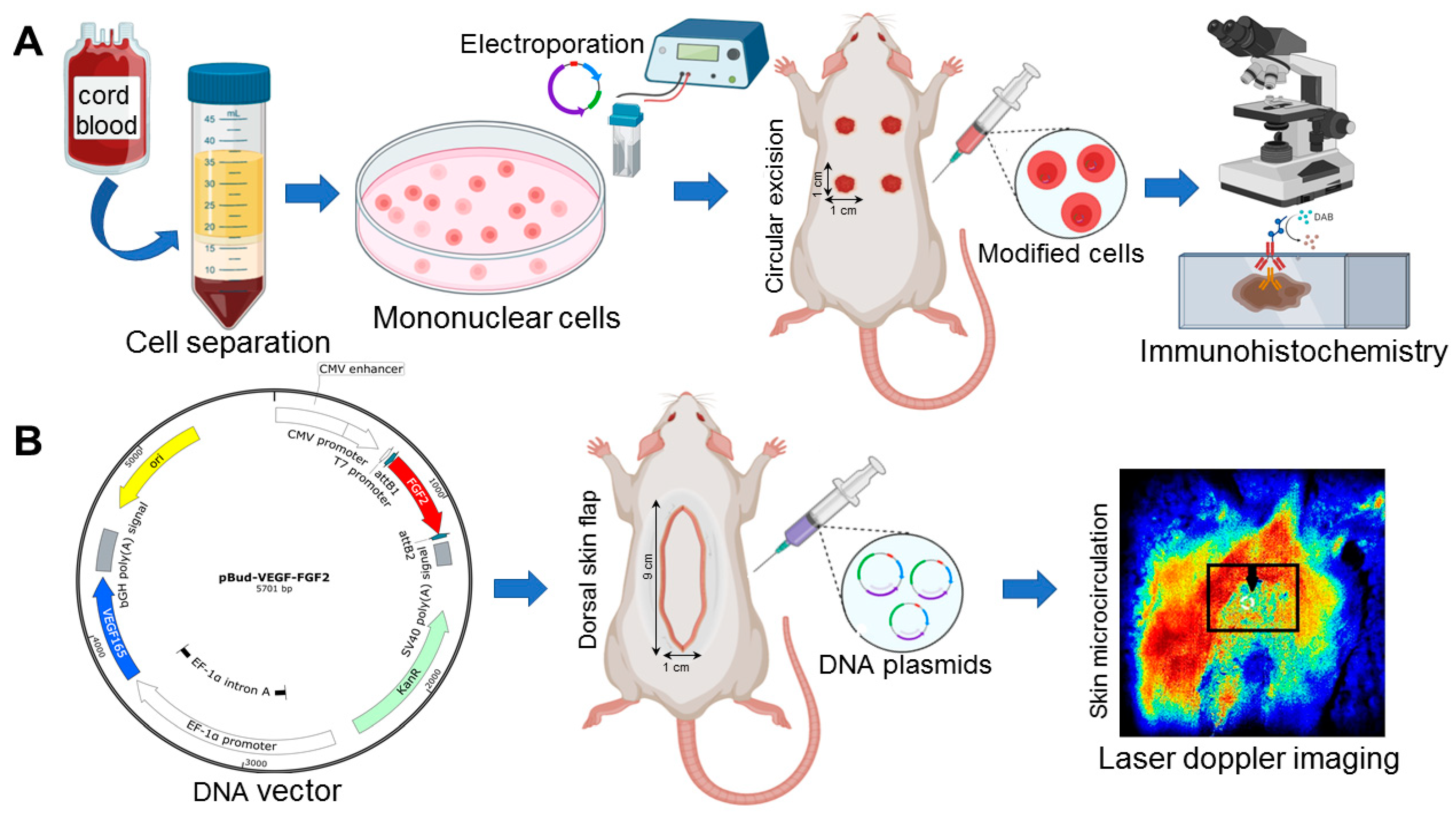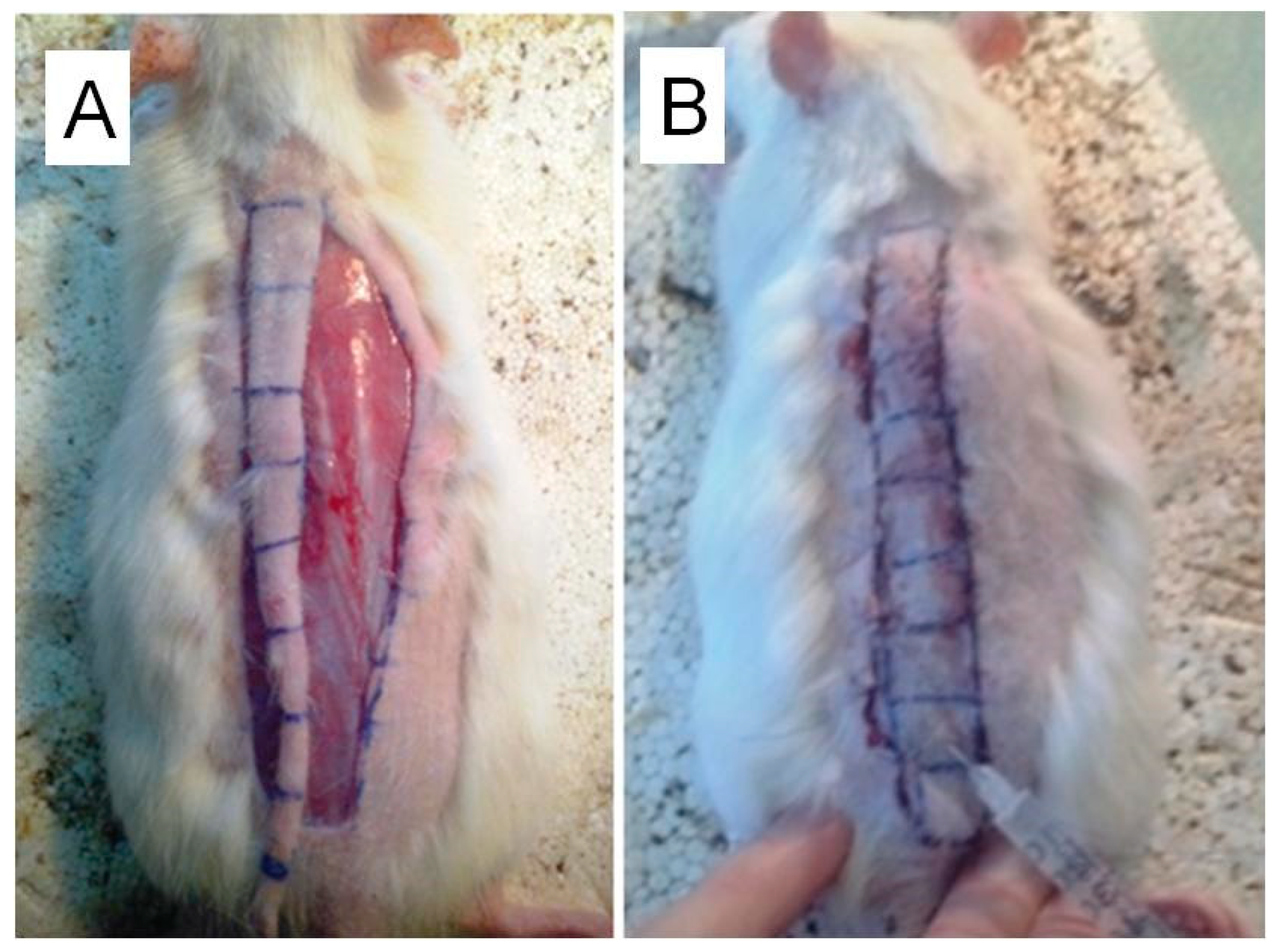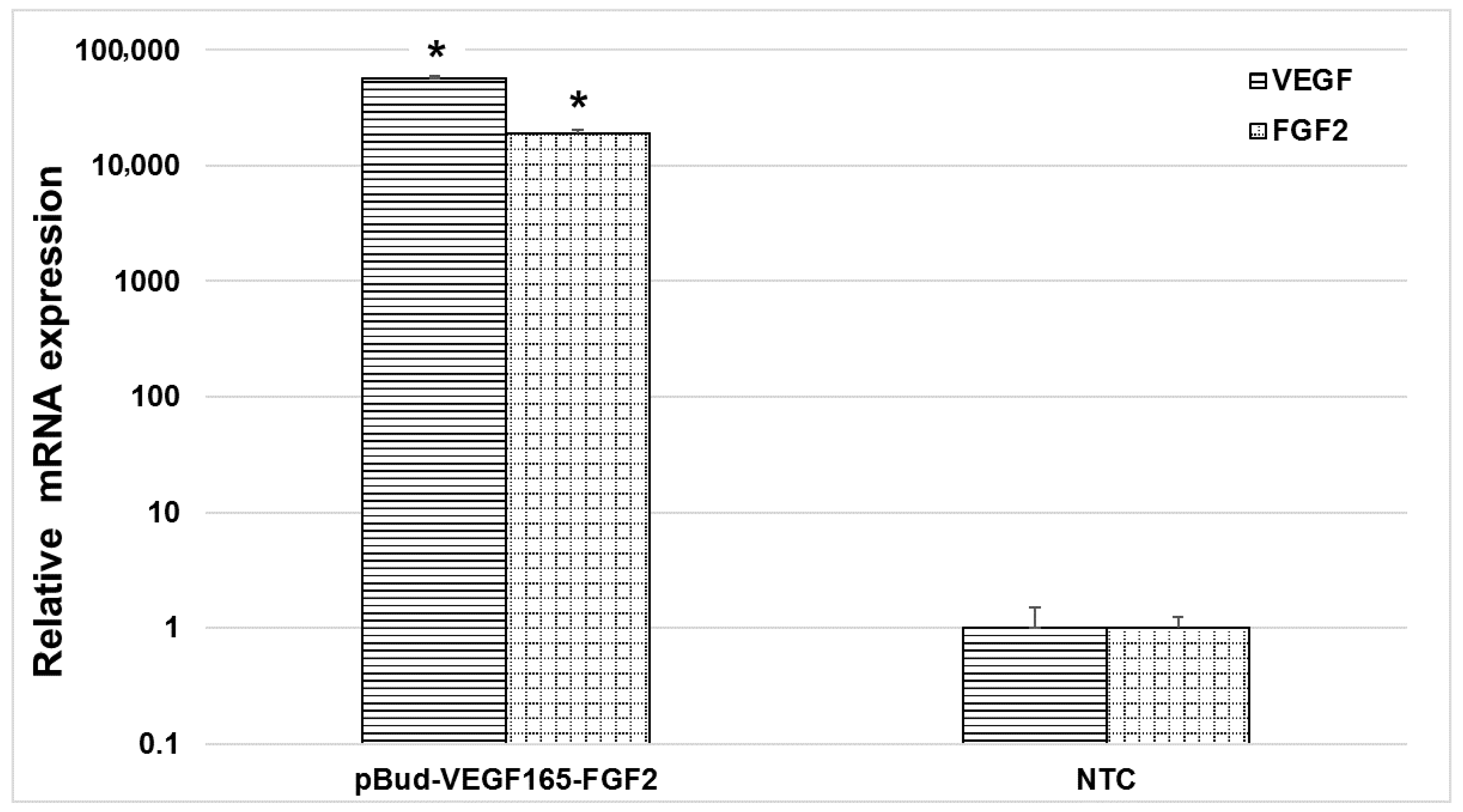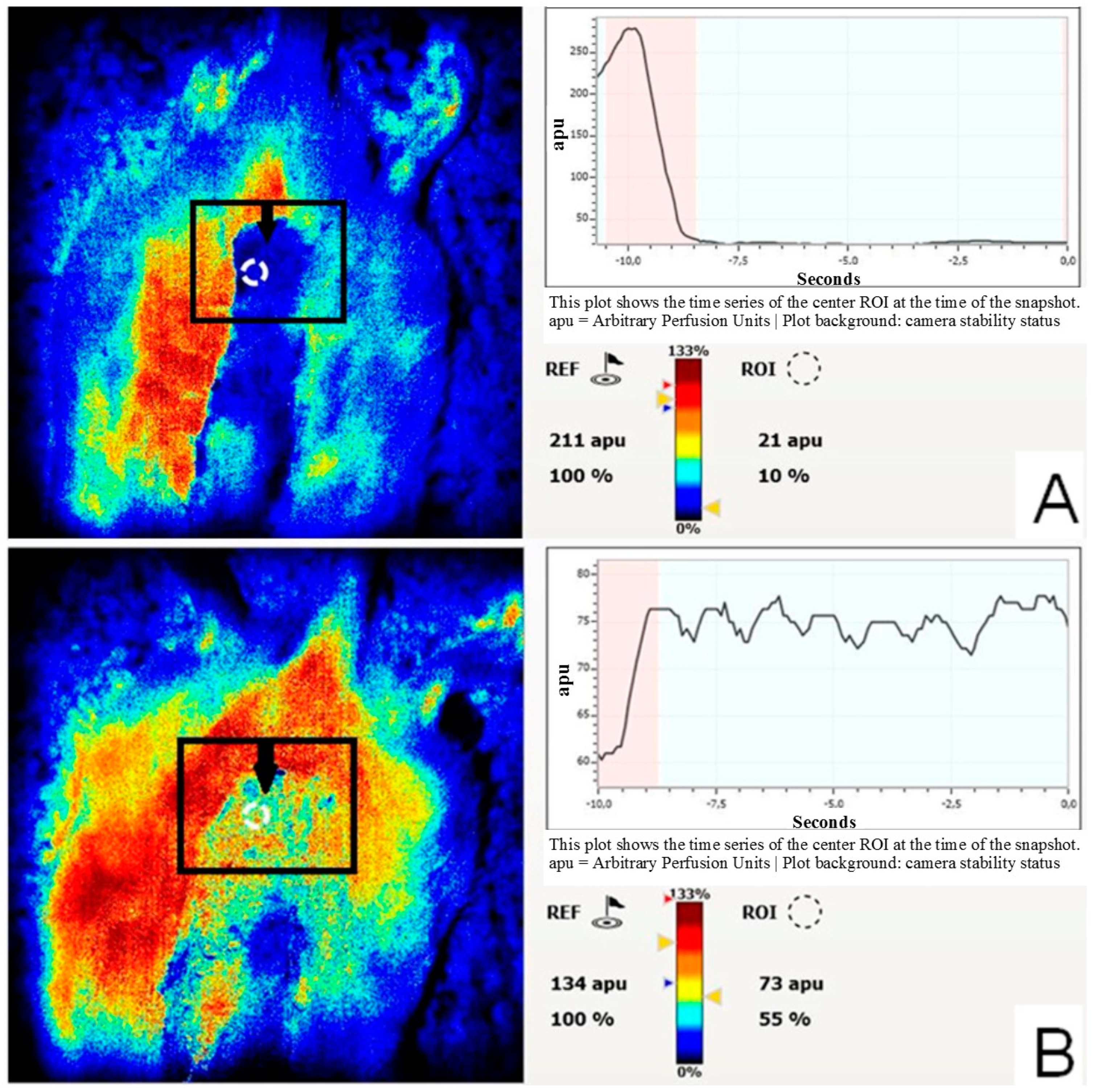Influence of Recombinant Codon-Optimized Plasmid DNA Encoding VEGF and FGF2 on Co-Induction of Angiogenesis
Abstract
Simple Summary
Abstract
1. Introduction
2. Material and Methods
2.1. Umbilical Cord Blood Mononuclear Cells
2.2. Plasmids Vectors
2.3. Quantitative Analysis of Transgenes Expression in Modified Umbilical Cord Blood Mononuclear Cells
2.4. Animals
2.5. Modelling and Treatment of Full-Layer Thickness Skin Wounds
2.5.1. Circular Excision Skin Wound Model
2.5.2. Skin-Fascial Flap Model
2.6. Histological Investigation
Morphometric Examination
2.7. Laser Doppler Imaging (LDI)
2.8. Statistical Analyses
3. Results and Discussion
3.1. Molecular Analysis of Gene Modified UCB-MC In Vitro
3.2. Effect of Transplanted Genetically Modified Cells on the Regeneration of Skin Defects Full-Thickness Skin Wounds
3.3. Effect of VEGF and FGF2-Expressing Plasmids on the Blood Flow in the Skin-Fascial Flap
4. Discussion
5. Conclusions
Author Contributions
Funding
Institutional Review Board Statement
Informed Consent Statement
Data Availability Statement
Conflicts of Interest
References
- Crozier, G.L. Medium-Chain Triglyceride Feeding over the Long Term: The Metabolic Fate of [14C] Octanoate and [14C] Oleate in Isolated Rat Hepatocytes. J. Nutr. 1988, 118, 297–304. [Google Scholar] [CrossRef] [PubMed]
- Gonzalez, A.C.D.O.; Costa, T.F.; Andrade, Z.D.A.; Medrado, A.R.A.P. Wound healing—A literature review. An. Bras. Dermatol. 2016, 91, 614–620. [Google Scholar] [CrossRef] [PubMed]
- Niemann, C.; Watt, F.M. Designer skin: Lineage commitment in postnatal epidermis. Trends Cell Biol. 2002, 12, 185–192. [Google Scholar] [CrossRef]
- El-Mesallamy, H.O.; Diab, M.R.; Hamdy, N.M.; Dardir, S.M. Cell-Based Regenerative Strategies for Treatment of Diabetic Skin Wounds, a Comparative Study between Human Umbilical Cord Blood-Mononuclear Cells and Calves’ Blood Haemodialysate. PLoS ONE 2014, 9, e89853. [Google Scholar] [CrossRef] [PubMed]
- 5Wu, Y.; Chen, L.; Scott, P.G.; Tredget, E.E. Mesenchymal stem cells enhance wound healing through differentiation and an-giogenesis. Stem Cells 2007, 25, 2648–2659. [Google Scholar]
- Tolar, J.; Blazar, B.R.; Wagner, J.E. Concise Review: Transplantation of Human Hematopoietic Cells for Extracellular Matrix Protein Deficiency in Epidermolysis Bullosa. Stem Cells 2011, 29, 900–906. [Google Scholar] [CrossRef] [PubMed]
- Rashidghamat, E.; McGrath, J.A. Novel and emerging therapies in the treatment of recessive dystrophic epidermolysis bullosa. Intractable Rare Dis. Res. 2017, 6, 6–20. [Google Scholar] [CrossRef]
- Li, D.-J.; Sun, T.-J.; Zhang, L.; Deng, H.-P.; Shen, C.-A.; Chai, J.-K. Mesenchymal stem cells promote incision wound repair in a mouse model. Trop. J. Pharm. Res. 2017, 16, 1317. [Google Scholar] [CrossRef]
- Schreurs, M.; Suttorp, C.M.; Mutsaers, H.A.; Kuijpers-Jagtman, A.M.; Von den Hoff, J.W.; Ongkosuwito, E.M.; Carvajal Mon-roy, P.L.; Wagener, F.A. Tissue engineering strategies combining molecular targets against inflammation and fibrosis, and umbilical cord blood stem cells to improve hampered muscle and skin regeneration following cleft repair. Med. Res. Rev. 2020, 40, 9–26. [Google Scholar] [CrossRef]
- Zhou, X.; Ning, K.; Ling, B.; Chen, X.; Cheng, H.; Lu, B.; Gao, Z.; Xu, J. Multiple Injections of Autologous Adipose-Derived Stem Cells Accelerate the Burn Wound Healing Process and Promote Blood Vessel Regeneration in a Rat Model. Stem Cells Dev. 2019, 28, 1463–1472. [Google Scholar] [CrossRef] [PubMed]
- Yang, R.; Liu, F.; Wang, J.; Chen, X.; Xie, J.; Xiong, K. Epidermal stem cells in wound healing and their clinical applications. Stem Cell Res. Ther. 2019, 10, 1–14. [Google Scholar] [CrossRef] [PubMed]
- Babakhani, A.; Nobakht, M.; Torodi, H.P.; Dahmardehei, M.; Hashemi, P.; Ansari, J.M.; Ramhormozi, P.; Yari, A.; Heidari, F. Effects of Hair Follicle Stem Cells on Partial-Thickness Burn Wound Healing and Tensile Strength. Iran. Biomed. J. 2020, 24, 99–109. [Google Scholar] [CrossRef]
- Umegaki-Arao, N.; Pasmooij, A.M.G.; Itoh, M.; Cerise, J.E.; Guo, Z.; Levy, B.; Gostyński, A.; Rothman, L.R.; Jonkman, M.F.; Christiano, A.M. Induced pluripotent stem cells from human revertant keratinocytes for the treatment of epidermolysis bullosa. Sci. Transl. Med. 2014, 6, 264ra164. [Google Scholar] [CrossRef]
- Efron, P.A.; Moldawer, L.L. Cytokines and wound healing: The role of cytokine and anticytokine therapy in the repair re-sponse. J. Burn Care Rehabil. 2004, 25, 149–160. [Google Scholar] [CrossRef]
- Guo, R.; Xu, S.; Ma, L.; Huang, A.; Gao, C. The healing of full-thickness burns treated by using plasmid DNA encoding VEGF-165 activated collagen–chitosan dermal equivalents. Biomaterials 2011, 32, 1019–1031. [Google Scholar] [CrossRef]
- Jeschke, M.G.; Klein, D. Liposomal gene transfer of multiple genes is more effective than gene transfer of a single gene. Gene Ther. 2004, 11, 847–855. [Google Scholar] [CrossRef]
- Hachiya, A.; Sriwiriyanont, P.; Patel, A.; Saito, N.; Ohuchi, A.; Kitahara, T.; Takema, Y.; Tsuboi, R.; Boissy, R.E.; Visscher, M.O.; et al. Gene transfer in human skin with different pseudotyped HIV-based vectors. Gene Ther. 2007, 14, 648–656. [Google Scholar] [CrossRef] [PubMed][Green Version]
- Pereira, C.; Herndon, D.; Perez-Polo, J.; Burke, A.; Jeschke, M. Scar trek: Follicular frontiers in skin replacement therapy. Genet. Mol. Res. 2007, 6, 243–249. [Google Scholar]
- Kawai, K.; Suzuki, S.; Tabata, Y.; Nishimura, Y. Accelerated wound healing through the incorporation of basic fibroblast growth factor-impregnated gelatin microspheres into artificial dermis using a pressure-induced decubitus ulcer model in genetically diabetic mice. Br. J. Plast. Surg. 2005, 58, 1115–1123. [Google Scholar] [CrossRef]
- Rizvanov, A.A.; Kiyasov, A.P.; Gaziziov, I.M.; Yilmaz, T.S.; Kaligin, M.S.; Andreeva, D.I.; Shafigullina, A.K.; Guseva, D.S.; Kiselev, S.L.; Matin, K. Human umbilical cord blood cells transfected with VEGF and L1CAM do not differentiate into neu-rons but transform into vascular endothelial cells and secrete neuro-trophic factors to support neuro-genesis—A novel ap-proach in stem cell therapy. Neurochem. Int. 2008, 53, 389–394. [Google Scholar] [CrossRef]
- Rizvanov, A.A.; Guseva, D.S.; Salafutdinov, I.I.; Kudryashova, N.V.; Bashirov, F.V.; Kiyasov, A.P.; Yalvaç, M.E.; Gazizov, I.M.; Kaligin, M.S.; Mukhamedyarov, M.A.; et al. Genetically modified human umbilical cord blood cells expressing vascular endothelial growth factor and fibroblast growth factor 2 differentiate into glial cells after transplantation into amyotrophic lateral sclerosis transgenic mice. Exp. Biol. Med. 2011, 236, 91–98. [Google Scholar] [CrossRef] [PubMed]
- Yuan, J.S.; Reed, A.; Chen, F.; Stewartjr, C.N. Statistical analysis of real-time PCR data. BMC Bioinform. 2006, 7, 85. [Google Scholar] [CrossRef]
- Bancroft, J.D.; Gamble, M. Theory and Practice of Histological Techniques; Elsevier Health Sciences, 2008. Available online: http://www.sciepub.com/reference/32572 (accessed on 17 February 2021).
- Zötterman, J.; Bergkvist, M.; Iredahl, F.; Tesselaar, E.; Farnebo, S. Monitoring of partial and full venous outflow obstruction in a porcine flap model using laser speckle contrast imaging. J. Plast. Reconstr. Aesthetic Surg. 2016, 69, 936–943. [Google Scholar] [CrossRef]
- Mortier, L.; Delesalle, F.; Formstecher, P.; Polakowska, R. Human umbilical cord blood cells form epidermis in the skin equivalent model. Exp. Dermatol. 2010, 19, 929–930. [Google Scholar] [CrossRef]
- Vourtsis, S.A.; Papalois, A.E.; Agrogiannis, G.D.; Spyriounis, P.K.; Patsouris, E.; Ionac, M. Improvement of a long random skin flap survival by application of vascular endothelial growth factor in various ways of local administration in a rat model. Indian J. Plast. Surg. 2012, 45, 102–108. [Google Scholar] [CrossRef]
- Basu, G.; Downey, H.; Guo, S.; Israel, A.; Asmar, A.; Hargrave, B.; Heller, R. Prevention of distal flap necrosis in a rat ran-dom skin flap model by gene electrotransfer delivering VEGF165 plasmid. J. Gene Med. 2014, 16, 55–65. [Google Scholar] [CrossRef] [PubMed]
- Fayazzadeh, E.; Yavarifar, H.; Rafie, S.R.; Motamed, S.; Anvari, M.S.; Boroumand, M.A. Fibroblast growth factor-1 vs. fibro-blast growth factor-2 in ischemic skin flap survival in a rat animal model. World J. Plast. Surg. 2016, 5, 274. [Google Scholar]
- Slobodkina, E.; Boldyreva, M.; Karagyaur, M.; Eremichev, R.; Alexandrushkina, N.; Balabanyan, V.; Akopyan, Z.; Parfyonova, Y.; Tkachuk, V.; Makarevich, P. Therapeutic Angiogenesis by a “Dynamic Duo”: Simultaneous Expression of HGF and VEGF165 by Novel Bicistronic Plasmid Restores Blood Flow in Ischemic Skeletal Muscle. Pharmaceutics 2020, 12, 1231. [Google Scholar] [CrossRef] [PubMed]
- Shi, R.; Lian, W.; Han, S.; Cao, C.; Jin, Y.; Yuan, Y.; Zhao, H.; Li, M. Nanosphere-mediated co-delivery of VEGF-A and PDGF-B genes for accelerating diabetic foot ulcers healing in rats. Gene Ther. 2018, 25, 425–438. [Google Scholar] [CrossRef]
- Jafari, S.M.S.; Shafighi, M.; Beltraminelli, H.; Weber, B.; Schmid, R.A.; Geiser, T.; Gazdhar, A.; Hunger, R.E. Efficacy of in vi-vo electroporation-mediated IL-10 gene delivery on survival of skin flaps. J. Membr. Biol. 2018, 251, 211–219. [Google Scholar] [CrossRef]
- Garanina, E.E.; Mukhamedshina, Y.O.; Salafutdinov, I.I.; Kiyasov, A.P.; Lima, L.M.; Reis, H.J.; Palotás, A.; Islamov, R.R.; Rizvanov, A.A. Construction of recombinant adenovirus containing picorna-viral 2A-peptide sequence for the co-expression of neuro-protective growth factors in human umbilical cord blood cells. Spinal Cord 2015, 54, 423–430. [Google Scholar] [CrossRef][Green Version]
- Shaimardanova, G.; Mukhamedshina, Y.O.; Rizvanov, A.; Salafutdinov, I.; Chelyshev, Y.A. Effects of transplantation of hu-man cord blood mononuclear cells expressing the recombinant VEGF and FGF2 genes into spinal cord traumatic injury sites in rats. Neurosci. Behav. Physiol. 2013, 43, 597–601. [Google Scholar] [CrossRef]
- Ikeda, Y.; Fukuda, N.; Wada, M.; Matsumoto, T.; Satomi, A.; Yokoyama, S.-I.; Saito, S.; Matsumoto, K.; Kanmatsuse, K.; Mugishima, H. Development of Angiogenic Cell and Gene Therapy by Transplantation of Umbilical Cord Blood with Vascular Endothelial Growth Factor Gene. Hypertens. Res. 2004, 27, 119–128. [Google Scholar] [CrossRef] [PubMed]
- Das, H.; George, J.C.; Joseph, M.; Das, M.; AbdulHameed, N.; Blitz, A.; Khan, M.; Sakthivel, R.; Mao, H.-Q.; Hoit, B.D.; et al. Stem Cell Therapy with Overexpressed VEGF and PDGF Genes Improves Cardiac Function in a Rat Infarct Model. PLoS ONE 2009, 4, e7325. [Google Scholar] [CrossRef]
- Agatieva, E.; Ksembaev, S.; Sokolov, M.; Markosyan, V.; Gazizov, I.; Tsyplakov, D.; Shmarov, M.; Tutykhina, I.; Naroditsky, B.; Logunov, D.; et al. Evaluation of Direct and Cell-Mediated Lactoferrin Gene Therapy for the Maxillofacial Area Abscesses in Rats. Pharmaceutics 2021, 13, 58. [Google Scholar] [CrossRef]
- Spanholtz, T.A.; Theodorou, P.; Holzbach, T.; Wutzler, S.; Giunta, R.E.; Machens, H.-G. Vascular endothelial growth factor (VEGF165) plus basic fibroblast growth factor (bFGF) producing cells induce a mature and stable vascular network—A fu-ture therapy for ischemically challenged tissue. J. Surg. Res. 2011, 171, 329–338. [Google Scholar] [CrossRef] [PubMed]
- McFarlane, R.M.; Deyoung, G.; Henry, R.A. The design of a pedicle flap in the rat to study necrosis and its prevention. Plast. Reconstr. Surg. 1965, 35, 177–182. [Google Scholar] [CrossRef]
- Oh, M.; Chang, H.; Minn, K.W. The Effects of Tadalafil on Axial-Pattern Skin Flap Survival in Rats. Dermatol. Surg. 2008, 34, 626–630. [Google Scholar]
- Barral, S.M.; Araujo, I.D.; Vidigal, P.V.T.; Mayrink, C.A.C.; Araujo, A.D.; Costa, P.R.d. Os efeitos do sildenafil na viabilidade de retalhos cutâneos randômicos. Acta Cir. Bras. 2011, 26, 314–319. [Google Scholar] [CrossRef] [PubMed][Green Version]
- Cai, L.Y.; Wang, T.; Lin, D.S.; Lu, D. [Effects and related mechanism of bivalirudin on the survival of random skin flap on the back of rat]. Zhonghua shao shang za zhi = Zhonghua shaoshang zazhi = Chin. J. Burn. 2017, 33, 228–232. [Google Scholar]
- Stone, R.; Rathbone, C.R. Microvascular Fragment Transplantation Improves Rat Dorsal Skin Flap Survival. Plast. Reconstr. Surg.Glob. Open 2016, 4, e1140. [Google Scholar] [CrossRef] [PubMed]
- Kano, M.R.; Morishita, Y.; Iwata, C.; Iwasaka, S.; Watabe, T.; Ouchi, Y.; Miyazono, K.; Miyazawa, K. VEGF-A and FGF-2 syn-ergistically promote neoangiogenesis through enhancement of endogenous PDGF-B–PDGFRβ signaling. J. Cell Sci. 2005, 118, 3759–3768. [Google Scholar] [CrossRef]
- Plotnikov, M.; Rizvanov, A.; Masgutov, R.; Mavlikeev, M.; Salafutdinov, I.; Gazizov, I.; Romanova, Y.; Shamsutdinova, I.; Bogov, A.; Maksimov, A. The first clinical experience of direct gene therapy using VEGF and bFGF in treatment patients with critical lower limb ischemia. CTTE 2012, 3, 7. [Google Scholar]
- Masgutov, R.; Zeinalova, A.; Bogov, A.; Masgutova, G.; Salafutdinov, I.; Garanina, E.; Syromiatnikova, V.; Idrisova, K.; Mul-lakhmetova, A.; Andreeva, D. Angiogenesis and nerve regeneration induced by local administration of plasmid pBud-coVEGF165-coFGF2 into the intact rat sciatic nerve. Neural. Regen. Res. 2021, 16, 1882. [Google Scholar] [CrossRef]
- Holzbach, T.; Vlaskou, D.; Neshkova, I.; Konerding, M.A.; Wörtler, K.; Mykhaylyk, O.; Gänsbacher, B.; Machens, H.G.; Plank, C.; Giunta, R.E. Non-viral VEGF165 gene therapy–magnetofection of acoustically active magnetic lipospheres (‘magne-tobubbles’) increases tissue survival in an oversized skin flap model. J. Cell Mol. Med. 2010, 14, 587–599. [Google Scholar] [PubMed]





Publisher’s Note: MDPI stays neutral with regard to jurisdictional claims in published maps and institutional affiliations. |
© 2021 by the authors. Licensee MDPI, Basel, Switzerland. This article is an open access article distributed under the terms and conditions of the Creative Commons Attribution (CC BY) license (http://creativecommons.org/licenses/by/4.0/).
Share and Cite
Salafutdinov, I.I.; Gazizov, I.M.; Gatina, D.K.; Mullin, R.I.; Bogov, A.A.; Islamov, R.R.; Kiassov, A.P.; Masgutov, R.F.; Rizvanov, A.A. Influence of Recombinant Codon-Optimized Plasmid DNA Encoding VEGF and FGF2 on Co-Induction of Angiogenesis. Cells 2021, 10, 432. https://doi.org/10.3390/cells10020432
Salafutdinov II, Gazizov IM, Gatina DK, Mullin RI, Bogov AA, Islamov RR, Kiassov AP, Masgutov RF, Rizvanov AA. Influence of Recombinant Codon-Optimized Plasmid DNA Encoding VEGF and FGF2 on Co-Induction of Angiogenesis. Cells. 2021; 10(2):432. https://doi.org/10.3390/cells10020432
Chicago/Turabian StyleSalafutdinov, Ilnur I., Ilnaz M. Gazizov, Dilara K. Gatina, Ruslan I. Mullin, Alexey A. Bogov, Rustem R. Islamov, Andrey P. Kiassov, Ruslan F. Masgutov, and Albert A. Rizvanov. 2021. "Influence of Recombinant Codon-Optimized Plasmid DNA Encoding VEGF and FGF2 on Co-Induction of Angiogenesis" Cells 10, no. 2: 432. https://doi.org/10.3390/cells10020432
APA StyleSalafutdinov, I. I., Gazizov, I. M., Gatina, D. K., Mullin, R. I., Bogov, A. A., Islamov, R. R., Kiassov, A. P., Masgutov, R. F., & Rizvanov, A. A. (2021). Influence of Recombinant Codon-Optimized Plasmid DNA Encoding VEGF and FGF2 on Co-Induction of Angiogenesis. Cells, 10(2), 432. https://doi.org/10.3390/cells10020432






